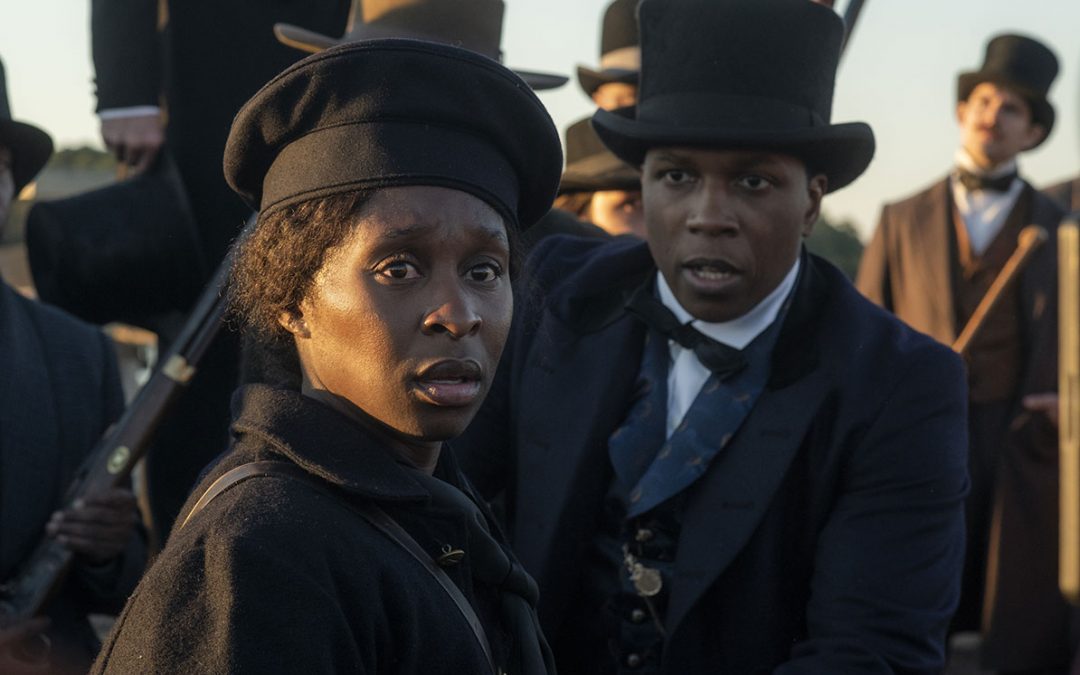WHAT’S THE STORY AND WHO IS IT DIRECTED BY?
The director of this film, Kasi Lemmons (Eve’s Bayou, Black Nativity, Talk To Me) is known for rebirthing hidden and unspoken legacies, and histories. In Lemmon’s Harriet, the protagonist of the film Harriet Tubman is played beautifully by Cynthia Erivo (Widows, Broad City, The Color Purpleon Broadway) as she truly embodies the spirit of Harriet Tubman. Thankfully, this film is not redundantly centered on the cotton plantation fields. Instead, it takes viewers on a journey from the South upwards to Canada.
Harriet does not mock Harriet Tubman’s real life faith in and reliance on God. A theme of divine intervention is delicately woven into the fabric of this narrative. The narrative of this film is nuanced and includes subtexts that depict: how the unjust institution of slavery not only held enslaved people bondage, but slave-masters and mistresses as well, the psychological residue of being stripped from family, the interaction between Blacks who were born free and those who were enslaved or once enslaved and so much more.
IT’S HARRIET ANY GOOD? EFFECTIVE?
Parents need to know that a free black woman is beaten, kicked in the face and dies as a result, the ‘N-word’ is used repeatedly as it was the social norms of this particular time period, slaves are beaten, branded, and separated from their families by their owners and their owners’ wives, and that there is some gun violence. There is bloodshed, but it all lends itself to giving an honest depiction of what slaves endured. Harriet is definitely effective as a teaching to for parents, teachers, reading groups as well as for debates and discussion in college settings. By getting a glimpse of Harriet Tubman’s personal life, viewers get the opportunity to see her not only as a historical figure, but rather a human being who experienced: not being able to have a married life with her first love as a result of the conditions of slavery. In this film, viewers will see how the family dynamic of the enslaved was destroyed as a result of the practices and social norms that accompanied thought patterns of the times.
LOVE-HATE RELATIONSHIP BETWEEN SLAVE OWNERS AND THE FEMALE SLAVES
There are many relevant subtexts intertwined within the plotline of the film. For example, there are many scenes between Harriet (Cynthia Erivo) and Gideon (Joe Alwyn), her slave-master’s son that allude to the often unspoken histories of the love-hate relationships that slave-owners often had with their Black, female slaves. Secondly, the on-screen interactions that Harriet had with Marie Buchanon (Janelle Monae), an affluent, beautiful free woman and William Still (Leslie Odom Jr.), a dignified historian, business man, writer and abolitionist, showcases the: advocacy and interconnectivity that folks of the Diaspora operated out of regardless of their stations in life. This unspoken spirit of unity is definitely a trait that this generation could benefit from by observing this film.
THE UNDERGROUND RAILROAD
The “Underground Railroad” is a major theme throughout Harriet. This film will definitely be an asset to parents who want to teach their children more about this very important period in time. Viewers of the film, will see depictions of intelligent, free Black men and women. They will also witness that there were many white allies that facilitated in the “Underground Railroad”.
Parents will get the opportunity to discuss with their children topics about the Underground Railroad as well as ‘white allies’. Younger audiences as well as teenagers will see Black people outside of the context of chains, adorned in tailored clothing and enjoying the liberty that life should offer all.
Due to the very realistic portrayal of some of the brutal abuse of women and slaves for conservative households, I recommend this film for ages 12 and up. For more parents who are not interested in sheltering their children from the truth at an early age, I recommend this film for ages 10 and up. This is definitely a family film for all demographics that is a nuanced teaching tool for showcasing a change-maker in history.
Starring Tony Award winning Cynthia Erivo in the title role, additionally the Harriet ensemble stars: Leslie Odom Jr., Janelle Monáe, Joe Alwyn, Jennifer Nettles, Clarke Peters, Vondie-Curtis Hall and Henry Hunter Hall. is directed by Kasi Lemmons, who co-wrote the film with Gregory Allen Howard. Debra Martin Chase, Daniela Taplin Lundberg, Gregory Allen Howard are the producers.
Harriet premieres in theaters on November 1, 2019. Learn more about the Harriet film official website here: http://www.focusfeatures.com/harriet


Recent Comments